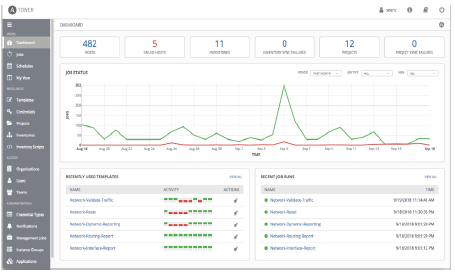Over the past couple of years, and especially during the pandemic, we have been approached by a number of clients looking to adopt more automation in the way they administer and deploy their IT estate. As a result, I want to address some of the questions that arise when considering the adoption of automation.
In terms of why businesses are increasingly turning to automation, there are a number of factors driving this trend, for example –
- Meet end-user and line of business expectations of ‘On Demand’ IT
Where historically a lead time of days or weeks for a new environment was accepted, cloud adoption has led today’s business and end-users to expect near-instant access or self-service provisioning
- Free up IT resources from the menial tasks
By removing the repetitive grind, the IT team can concentrate on new initiatives to drive business value
- Provision complex environments without the need to consume valuable IT resources
As environments grow increasingly complex, with often multiple technologies and skillsets involved – through automation, these tasks can be completed without the need to tie up one or more highly skilled consultants
- Achieve consistent, repeatable outcomes without manual intervention
Whilst many organisations produce a runbook for any member of an IT team to complete a task, there can often be nuances or discrepancies in how the task is completed. Through automation, the task gets completed the same way, every time – removing the chance of user error
- Manage growing environments with the same or fewer staff
Whilst most IT environments are growing, either organically or via the adoption of containerised microservices to add business value, the IT organisation almost certainly isn’t. As a result, teams need to work smarter to prioritise the important tasks and offload routine jobs to automation
When considering automation, most clients think of Ansible but for many, this is a new technology in which they have little or no experience. We appreciate in IT, as in many professional disciplines, there is often an unhelpful trend of avoiding the simple questions even though this basic understanding is a critical foundation to everything that leads on. As a result, we normally start the conversation at the ground and build-up – starting with the most fundamental of ‘What is Ansible?’
What is Ansible?
In a nutshell, Ansible is a very simple IT automation platform that makes your systems and applications easier to deploy.
Ansible is open source and can either be used for free or with a commercial support agreement from Red Hat. This gives the option to try out Ansible’s capabilities for free with the option to enrol in a support agreement if the decision is taken to roll the platform into Production. There are no agents to deploy or manage to end systems and it provides highly flexible and configurable systems management, with rollback capability in the case of configuration error.
A key concept in Ansible is a Playbook – this is a workflow of tasks that Ansible will execute to complete an activity – such as patching a system or provisioning an environment.
Ansible Tower is available on a commercial subscription from Red Hat and extends the value of Ansible by provides a user-friendly graphical user interface. This GUI centralises the inventory, provides a health and activity dashboard and allows execution of Playbook activities.

Why Use Ansible?
Due to the highly flexible and configurable nature of Ansible, it can be used to address a number of challenges. The key Ansible Use Cases include:
- Configuration management
- Application deployment
- Continuous delivery
- Provisioning
- Orchestration
- Security automation
Can I use Ansible with my AIX and IBM i estate?
Yes – All POWER, Z and x86 Operating Systems are supported Ansible endpoints. Ansible can be used to perform routine maintenance operations such as patching, application and program deployment, work management, security management or the running of adhoc scripts, CL or SQL for specific administrative tasks.
Expanding on administrative activities, Ansible can be used to automate the build, unit test and deploy processes to support continuous development workstreams and can be combined with IBM Cloud Automation Manager (CAM) to deploy workloads in the cloud or on-premise. As Ansible works with heterogeneous environments across platforms, automated activity can occur within a structured playbook to build or modify environments on both Power and x86.
As an IBM Platinum partner and a Specialist in IBM Power and Storage infrastructure and a Microsoft Gold partner, Northdoor can help guide you through the options open to you.
Summary
We firmly believe that the use of automation is going to play a key role in allowing businesses to improve their efficiency and level of service to both internal and external users. As the high-level overview above demonstrates, Ansible is a very powerful, cross-platform automation tool that can be leveraged to great effect when applied correctly.
If you’re interested in finding out more, please get in touch. In a typical engagement, the first step would be an introductory workshop to understand the challenges that you would like to solve via automation and a broader outline of the Ansible stack. Following this workshop, we will propose an architecture to address your challenges – all of our solutions are bespoke to our client’s needs. Should you decide to proceed, Northdoor can implement and proactively manage your ansible deployment
Tom is a highly skilled and experienced IT specialist with a proven track record and demonstrated success in providing first-class solutions to complex problems on time and under pressure along with consistent over achievement of targets; in both commercial and career development. He has proven his ability to combine technical knowledge and understanding with a strong commercial awareness in order to deliver value and realisable business benefits to clients.



